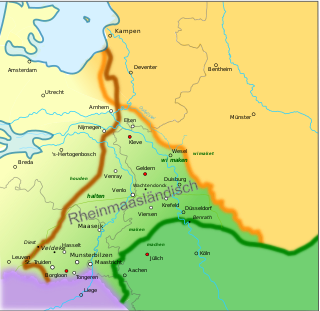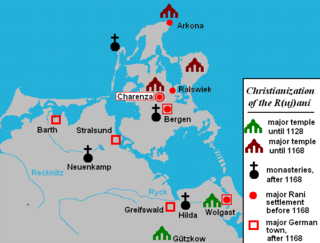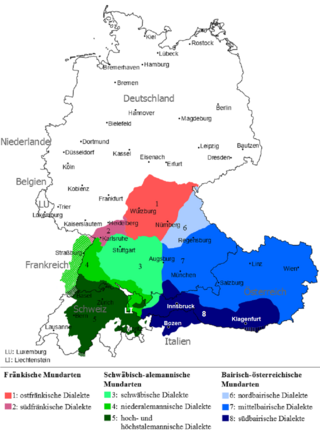Related Research Articles

In historical and comparative linguistics, Low Franconian is a linguistic category used to classify a number of historical and contemporary West Germanic varieties closely related to, and including, the Dutch language. Most dialects and languages included within this category are spoken in the Netherlands, northern Belgium (Flanders), in the Nord department of France, in western Germany, as well as in Suriname, South Africa and Namibia.
Standard High German (SHG), less precisely Standard German or High German, is the umbrella term for the standardized varieties of the German language, which are used in formal contexts and for communication between different dialect areas. German is a pluricentric Dachsprache with currently three codified specific national varieties: German Standard German, Austrian Standard German and Swiss Standard German.

In German orthography, the letter ß, called Eszett or scharfes S, represents the phoneme in Standard German when following long vowels and diphthongs. The letter-name Eszett combines the names of the letters of ⟨s⟩ and ⟨z⟩ in German. The character's Unicode names in English are double s, sharp s and eszett. The Eszett letter is currently used only in German, and can be typographically replaced with the double-s digraph ⟨ss⟩, if the ß-character is unavailable. In the 20th century, the ß-character was replaced with ss in the spelling of Swiss Standard German, while remaining Standard German spelling in other varieties of the German language.
The German orthography reform of 1996 was a change to German spelling and punctuation that was intended to simplify German orthography and thus to make it easier to learn, without substantially changing the rules familiar to users of the language.
Early New High German (ENHG) is a term for the period in the history of the German language generally defined, following Wilhelm Scherer, as the period 1350 to 1650, developing from Middle High German and into New High German.

Old High German is the earliest stage of the German language, conventionally identified as the period from around 500/750 to 1050. Rather than representing a single supra-regional form of German, Old High German encompasses the numerous West Germanic dialects that had undergone the set of consonantal changes called the Second Sound Shift.

East Low German is a group of Low German dialects spoken in north-eastern Germany as well as by minorities in northern Poland. Together with West Low German dialects, it forms a dialect continuum of the Low German language. Before 1945, the dialect was spoken along the entire then-German-settled Baltic Coast from Mecklenburg, through Pomerania, West Prussia into certain villages of the East Prussian Klaipėda Region.

The Duden is a dictionary of the Standard High German language, first published by Konrad Duden in 1880, and later by Bibliographisches Institut GmbH, which was merged into Cornelsen Verlag in 2022 and thus ceased to exist.

Konrad Alexander Friedrich Duden was a German philologist and teacher. He founded the well-known German language dictionary bearing his name Duden.
New High German is the term used for the most recent period in the history of the German language, starting in the 17th century. It is a loan translation of the German Neuhochdeutsch. The most important characteristic of the period is the development of a standard written German, followed by the standardisation of the spoken language. For this reason, the term New High German is also used as a synonym for modern Standard German.
Rudolf von Raumer was a German philologist and linguist, known for his extensive research of the German language. He was the son of geologist Karl Georg von Raumer.

In linguistics, Meuse-Rhenish is a term with several meanings, used both in literary criticism and dialectology.
Swiss Standard German, or Swiss High German, referred to by the Swiss as Schriftdeutsch, or German: Hochdeutsch, is the written form of one (German) of four national languages in Switzerland, besides French, Italian, and Romansh. It is a variety of Standard German, used in the German-speaking part of Switzerland and in Liechtenstein. It is mainly written and rather less often spoken.

The Rani or Rujani were a West Slavic tribe based on the island of Rugia (Rügen) and the southwestern mainland across the Strelasund in what is today northeastern Germany.
The planned German spelling reform of 1944 was a failed attempt to amend German orthography. Although one million copies of the new rules were printed by 1944 for school use, the reform was never introduced. Their preparation was initiated by the Reich Education Minister Bernhard Rust and they were drawn up by Otto Basler, Erich Gierach and Karl Reumuth.

Philipp von Zesen, also Filip Cösius or Caesius was a German poet, hymnist and writer. Some of his works are published under his pen name Ritterhold von Blauen.

Upper German is a family of High German dialects spoken primarily in the southern German-speaking area.
The German language developed differently in East Germany (DDR), during its existence as a separate state from 1949 to 1990, from the German of West Germany because of significant differences in the country's political and socio-cultural environment. Additionally, from the late 1960s onwards the political leaders of the DDR were intent on affirming the independence of their state by "isolationist linguistic politics" with the objective of demarcating East Germany from West Germany by actively reducing the unity of the German language.
Walter Heuer was Chefkorrektor at the Neue Zürcher Zeitung and author of the book Richtiges Deutsch. He was a central figure in the area of German orthography, especially in the German-speaking part of Switzerland.
References
- ↑ Peter von Polenz: Deutsche Sprachgeschichte vom Spätmittelalter bis zur Gegenwart – Band III – 19. und 20. Jahrhundert. Walter de Gruyter, 1999, p. 240
- ↑ Wolfgang Kopke: Rechtschreibreform und Verfassungsrecht. J.C.B. Mohr (Paul Siebeck) Tübingen, 1995, p. 28
- ↑ Edited by Werner Besch, Anne Betten, Oskar Reichmann, Stefan Sonderegger: Sprachgeschichte: Ein Handbuch zur Geschichte der deutschen Sprache und ihrer Erforschung – 2., vollständig neu bearbeitete und erweiterte Auflage – 3. Teilband (Hanbücher zur Sprach- und Kommunikationswissenschaft, Band 2.3), Walter de Gruyter, 2003, p. 2495 (chapter "Geschichte der Interpunktionssysteme im Deutschen").
- ↑ Ulrich Ammon: Die deutsche Sprache in Deutschland, Österreich und der Schweiz. Das Problem der nationalen Varietäten. Walter de Gruyter, 1995, p. 254
- ↑ Edited by Gerhard Helbig, Lutz Götze, Gert Henrici, Hans-Jürgen Krumm: Deutsch als Fremdsprache. Ein internationales Handbuch. 1. Halbband. Walter de Gruyter, 2001, p. 496f.
- ↑ "IETF Language Subtag Registry". IANA. 6 August 2021. Retrieved 7 October 2021.